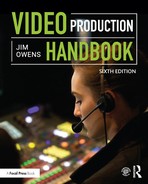CHAPTER 10
Working with the Talent
Actors are the life’s blood of any show. The best screenplay is only as good as the players performing the text.
David K. Irving, Director
Always get more sleep than your actors.
Orson Welles, Director
People have an incredible impact on a production. The face and the body language of a person communicate faster to an audience than any other method. Showing a CU of the face quickly communicates the story as the actor expresses disgust, joy, sorrow, and seriousness. Many video productions totally rely on how well people perform in front of the camera. It is up to the director to get the best performance from the talent. The director must be able to communicate his or her vision for the program and keep the talent motivated and informed. Coaxing the best performance can be tough, but it is well worth it in the end.
10.1 TALENT
With the competing television channels and Internet, television commentators have the difficult task of being innovative every time they are on the air. Research is the commentator’s weapon in being able to comment on the really important issues and describe the images provided to the audience.
Kostas Kapatais, Producer
Although the broad term “talent” is widely used to refer to those appearing in front of the camera, we must always remember how varied this talent really is. “Talent” covers a remarkable spread of experience and temperaments, from the professional actor working to a script and playing a part, to the impromptu, unrehearsed interview with a passerby on the street (Figure 10.1).

FIGURE 10.1
“Talent” generally refers to anyone who appears in front of the camera. That can include a wide variety of people, from anchors to actors to athletes to the man on the street doing an interview.
When the director invites someone to appear in front of the camera, that is only the beginning of the story. The person’s performance can have an incredible influence on the program’s success. It is important that the director helps in any way needed to make the talent’s contribution as effective as possible. The talent’s specific role may be major or it may be slight, but the impression he or she makes on the audience can decide whether that part of the program is a success or failure. The television camera can be an unwavering critic. Under its scrutiny, the audience weighs arrogance, attitude, and credibility, while sending sympathy to those who are shy and ill at ease.
For practical purposes, we can divide talent into the professional performers, who are used to appearing in front of the camera, and the inexperienced, for whom the program is likely to be a new, strange, and exciting, yet worrying event.
Professional performers usually like to work through a prepared format. Some, like an actor in a play, will learn their lines, their moves, and the mechanics of the production. Others work from an abbreviated cue sheet near the camera or read running text from the screen of a teleprompter. Some will extemporize from guide notes, while others will read from a printed script (Figures 10.3 and 10.4).
The best professionals can be relied on to repeat, during the actual taping, the dialog, the moves, the pace, and the timing that they gave in rehearsal. The talent needs to know what he or she is going to say and that he or she can modify the delivery of the piece to fit the situation, showing enthusiasm, vigor, calm detachment, patience, or reverence. Talent can take guidance and instructions and follow this through without being confused. Good talent can improvise when things go wrong and remain calm if the unexpected happens (Figures 10.5, 10.6, and 10.7).
HIGH-DEFINITION MAKEUP
HD forced the industry to produce better artists. HD makeup artists have to watch what they do more, watch how much paint they use, and be more artistic.
Matthew Mungle, Oscar Winner
Makeup changed with the onset of high-definition television (HD). It intimidates some actors because they know that the clarity of the signal can show every flaw. HD can show a single strand of out-of-place hair:
■ It is important that the talent feels comfortable with his or her new makeup on HD.
■ Usually artists select makeup that is much less colored than traditional set makeup.
■ More attention is usually spent on application.
■ More and more artists are using an airbrush for makeup application.
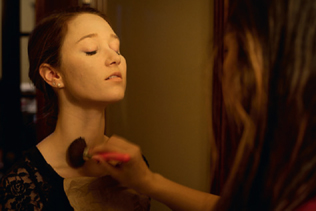
FIGURE 10.2
It is important that the talent feels comfortable with his or her new makeup.
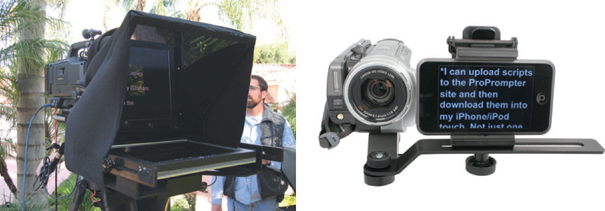
FIGURE 10.3
Teleprompters are generally attached in front of the lens of the video camera. Video or text can be placed on the prompter, allowing the talent to see the program or read the script while looking into the camera lens. Portable teleprompters, such as the software/app used on an iPhone in the second photo, are increasingly being used in the field.
(App photo courtesy of Bodelin Technologies)
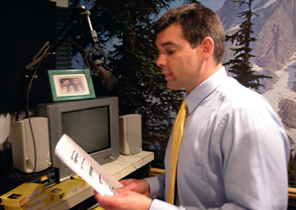
FIGURE 10.4
News talent records voiceovers for story packages.
(Photo by Jon Greenhoe)
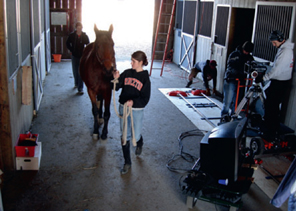
FIGURE 10.5
Talent must be able to concentrate on the work, even with a lot of distractions going on involving cameras, audio personnel, lighting, and other crew members.
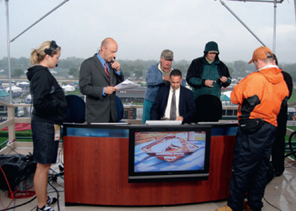
FIGURE 10.6
Note that while these two ESPN sports commentators rehearse, audio and production personnel are working around them, testing their mics and adjusting the talent’s headset on his neck.
(Photo by Josh Taber)
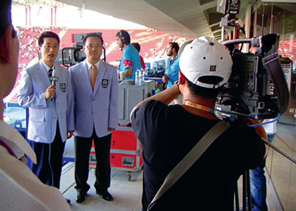
FIGURE 10.7
A “standup” is when talent are placed in front of something that provides context for the story being covered.
10.2 TALENT AND PRODUCTION STYLES
The talent needs to understand the various types of programs in order to know how to act:
■ Recorded program. Since this type of program is being recorded and then edited in postproduction, the recording can be stopped and started again. This takes pressure off of the talent, knowing that everything can be edited after the show has been recorded.
■ Live program. During a program that is live, the show is being broadcast and cannot be stopped and restarted. This puts the ultimate amount of tension on the talent because, no matter what happens, the show must go on. This means that the talent must be able to work without a script at times, ad-libbing as needed.
■ Live-to-tape program. This type of program is treated like a “live” program, without stopping the action. However, errors can be corrected in postproduction before it is broadcast or distributed.
Any director using talent who is not used to working to a camera has to make certain allowances that are not necessary when professional performers are involved. How well inexperienced people fit into their roles in the program will depend to an extent on the director. Do not expect new talent to have the self-discipline and efficiency of a professional. There is, after all, a scary novelty about finding yourself faced with an impersonal camera, a microphone pointing to pick up your slightest remark, unfamiliar people grouped around, lighting, and all kinds of disruptions. The occasion can become unreal to inexperienced talent.
The difference between being a director and being an actor is the difference between being the carpenter banging the nails into the wood and being the piece of wood the nails are being banged into.
Sean Penn, Actor
WHAT DO I WEAR?
Talent often ask the question: “What do I wear to this shoot?” Good question. Here are some basic guidelines:
■ Appropriateness is key. The clothing needs to fit the situation. If it is a studio interview, you want the talent to wear nicer clothes. If they are on location at a car race, you won’t want them in a suit. If they are on a dramatic set, they need to dress to fit the character, which may mean dirty shoes, T-shirt, and jeans. The clothing needs to fit the situation.
■ Wear low-contrast clothes. Contrasting colors are a major problem. Video cameras see differently from the human eye. Cameras cannot handle the contrast between light and dark objects. When the camera shows detail in the light object, the dark becomes indistinguishable. The reverse is also true: when detail is shown in the dark, the light colors become washed out, losing all of their detail. Contrast is also a problem for clothing and skin tone. Very light-skinned people should stay away from black or dark clothing when on television, and dark-skinned people should avoid wearing white or very light colors such as white, pink, and yellow. White clothing, including shirts or blouses, is discouraged for television.
■ Blue is universal on television. The clothing color that seems to work best on television is a medium blue.
■ Minimal jewelry is used on television. Generally talent wears small jewelry, since large, shiny objects cause glares from the lighting. Small chains or pearls are usually non reflective. There are times that even watches can cause problems.
■ Street makeup is usually appropriate. HD cameras are so sensitive that they no longer require the heavy makeup used in early television. Of course, special makeup may be required in order to fit a certain look or character.
10.3 THE INTERVIEW: GO BEYOND THE OBVIOUS
Asking the right questions when doing an interview is the key to capturing the audience’s attention. However, many times it is tough to know how far to push to get the needed information. Here are a few suggestions about interviewing:
■ Try to bring a fresh perspective. This requires the talent to think about the various story angles. It also may include trying to find new sources for information.
■ Talk about the time leading up to the event being discussed. This will provide background information that may shed light on what happened.
■ Knowing the terminology will keep the talent from getting lost in the middle of the interview. That means it may be important to explain that terminology to the viewers to increase their understanding.
■ Do some research. Make phone calls and ask questions, look for information online, visit the site where the event took place, find photos or video of the event. Be knowledgeable about the subject.
■ Talent should get multiple sources about the subject so that they can see the various perspectives.
10.4 SELECTING TALENT
New directors often have to deal with limited budgets, and one of the areas they often are tempted to cut is the budget line for professional talent. There are basically three types of talent for productions:
■ Professional talent. Professionals cost more money up front. However, their quality usually facilitates a better final project, and they usually can complete the project much faster than the two types of talent discussed next.
■ University/college theater performance students. Directors can usually “hire” students for very little money or even for free. The advantage is that these students have usually received training in acting and are often willing to work hard just for an experience they can put on their resume. So these students cost less than professionals but may take a bit more time to create the final project, including more retakes.
■ Amateur talent. It is always tempting to grab a relative or friend to be the talent on a project. The problem is that amateurs do not have the experience needed to complete the project in a timely fashion or to master the pronunciation.
In summary, although they may be free, amateur talent may actually cost more money than professional talent if equipment or studio space is being rented for the production. The cost you save on talent may be spent on rental costs, because the amateur can take much more time to complete a script. Not only can you save money by using professional talent, but the overall quality will be better.
WORKING WITH NEW TALENT
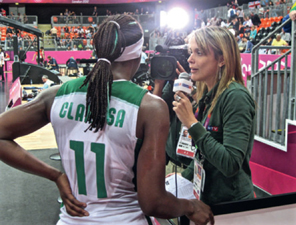
FIGURE 10.8
The experienced interviewer can help inexperienced guests in many ways:
■ put them at ease, explain what will be happening;
■ give them clear instructions, such as where to look and the direction you want the interview to go;
■ keep the area clear of distractions;
■ place items on a prearranged mark;
■ be aware of the time limits.
10.5 INEXPERIENCED TALENT
Many people who appear to be “natural performers” in the final program are really the product of an understanding and creative director. Typical ways of handling inexperienced talent include the following:
■ You can put your performers at ease by making them feel welcome, letting them know what they need to do, making them feel that their contribution is an important and interesting part of the program, and assuring them that if anything goes wrong, there is nothing to worry about because the scene can be recorded again (unless it is a live program).
■ Let them do it their way, and then edit the result.
■ Let them reminisce, for example, and then select the most interesting or the most relevant parts.
■ Interview them in a situation that is natural for them (such as their workshop) rather than in a formal studio setting.
■ Give them a few instructions, such as telling them when, where, or how to hold the items in front of the camera.
■ Use plenty of cutaway shots so that the program does not concentrate on the talent all of the time.
In a scripted program, it may be wise to record the dress rehearsal and, if possible, to run through the material several times, recording everything, so that the director can select and combine the best parts of each version.
If sections do not edit well, the interviewer can record a question or a statement later that will bridge what would otherwise be disjointed material. With care, this can be done quite well, even though it was not part of the original interview.
THE ACTOR’S CRAFT
10.6 THE HOST
Many of the problems of handling inexperienced talent can be reduced if someone who is familiar with the production routine offers support. The person who serves as the host will probably meet the guest beforehand, help the person to feel at ease, and explain what will be happening during the program (Figure 10.9). The host can also gently guide the guest through the interview by posing the questions within the right context: “Earlier, you were telling me about …” or “I wonder if we could look at …” or “Isn’t the construction of this piece interesting?” The host can move the program smoothly from one topic to the next. Especially when shooting intermittently or out of order— both very confusing to the novice talent—the host can be very effective at guiding the guest through the production.
In situations where the talent will be discussing an object that must appear on camera, the host can help the guest know how to handle the object. Instead of the nervous guest holding the prop in a way that does not work for television (partly hiding it, reflecting the lights, or moving it around in a CU), the host can tactfully take it from the guest to look at it and then hold it in a way that facilitates a good camera shot. At times, the host can also look in a nearby monitor to check the shot.
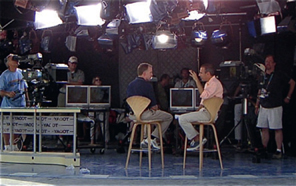
FIGURE 10.9
One of the hosts from NBC’s Today show, sitting in the light shirt, is prepping his guest for the next segment of the program.
THE ACTOR
A jolt of panic rises in even the most experienced actor when he starts to perform in front of other people, even if it is just a rehearsal. He is putting all his talent and self-image on the line and is probably terrified that his audience may not buy into what he is doing. What if the crew hates it? It would be a personal rejection of the actor. The more he uses his own psyche to build the character, the more vulnerable he becomes. There is one key principle about working with actors: Actors must feel they are in a place where they are totally safe.
John Badham, Director
10.7 THE OFF-CAMERA HOST
Talent does not always appear on camera. Some hosts are required to sit in a booth and commentate while watching the event on monitors. As pay-per-view Internet-extended versions of broadcast programs continue to grow in popularity, this practice will increase. The problem with off-camera broadcasting is that the talent needs to keep the excitement in their voice and act as though they are there. This can be difficult at times when the talent may not even be in the area of the event (Figure 10.10).

FIGURE 10.10
This reporter is commenting on a sporting event broadcast worldwide on NBC.com. Keeping your energy going as a commentator, when you are not actually at the event, can be difficult.
When There Are Problems
There are times when the invited guests simply do not live up to expectations. Perhaps he is too stiff. Or maybe she is so hesitant and nervous that she does her self little justice. Then there are the guests who overcompensate and become loud and obnoxious. In a live show, there may be little opportunity to actually replace someone. If there is a rehearsal and it is obvious that the guest is not going to work, it is possible to cut that individual from the show. However, doing so can create a difficult situation. It may be possible to record the segment instead of going live, in the hope you will be able to use at least some of the person’s contribution. If a shaky performance becomes a serious issue, it can be cut in postproduction.
Other ways to deal with a problematic guest are to simplify or to shorten the person’s segment. You can use multiple cutaways, such as CUs of details, to cover the edits during postproduction. If necessary, these cutaways can be shot after the main show is recorded.
Another approach is to have the host present the items in the program while continually referring to the guest. For example, the host could pick up an item, hold it to camera, and remind the guest of the information they discussed before or during rehearsal. At worst, the guest has to do little more than say yes and no.
As a last resort, you can use a voiceover track for the guest’s segment and use video images of the subject matter.
10.8 PRESENTING THE INFORMATION
Just because the talent may be an expert about a specific subject does not mean that he or she can present it convincingly to the camera. Ironically, there are times when a talent working from a teleprompter script may appear more authen tic, even though the words may have been written by someone else.
How the action is shot is influenced not only by the nature of the subject but by the talent involved. The camera can behave like a bystander who moves around to get a good view of whatever is going on. This happens in street interviews. At best, one hopes that whoever is being interviewed will be preoccupied with the questioner and barely notice the camera and microphone. However, it can sometimes be difficult to relax when one is being besieged by the curiosity of bystanders.
10.9 IMPORTANCE OF PEOPLE IN THE SCENE
Suppose you are shooting a production about a town. You are describing its character and its special features and showing details of its buildings. Shooting early in the morning, before people are moving around, provides a great opportunity to get clear, uncluttered views. However, do the shots really convey the town’s typical atmosphere?
On the other hand, if you begin shooting once the town has come to life so that you can capture the hustle and bustle of passing traffic, it may be difficult to get the required shots, although the place now has exactly the right feel to it. This is a reminder that there may be advantages to shooting various aspects of the subject at different times, according to the light, the weather, and the passing crowd (Figure 10.11).
Finally, do not overlook how important people are in giving life to a scene. Rather than pan along an empty sidewalk, it is more interesting to follow someone who is passing (although there is the possibility that the audience may now wonder who this newcomer is, speculating on the person instead of on the real subject).
A shot looking along an empty bridge is likely to bore your audience within a few seconds. But have someone walk across that same bridge, and the scene immediately becomes more interesting. Now you can hold the shot much longer while a voiceover tells us about the bridge’s history.
Selecting the right talent to fit the script and then helping the talent understand what you need from him or her to make a successful production are two of the director’s greatest challenges. However, when the talent gets it right, with the right script and with the right director, the results can be incredible.
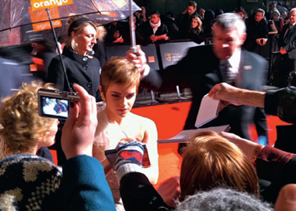
Figure 10.11
People bring life to scenes, making the image more interesting to the audience. This image captured the atmosphere of the red carpet at the British Academy Awards.
10.10 SAFETY
The crew always needs to look out for the talent’s safety. The talent is often looking at the camera or concentrating on the script and may not see someone or something approaching from the side. They have to be protected against tripping on cables, walking off curbs, or getting too close to hot lights. When working in heat, you also have to make sure that they are hydrated.
Kristin Ross Lauterbach, Director
Why do you like to direct?
I have always been a visual storyteller. I love the collaborative nature of the process, as well as the interaction with all the arts. As a director, I have the opportunity to experience the whole journey of the film from words on a page to moving, talking images on a screen. As a lover of books, art, and music, directing utilizes all these crafts without the need to be an expert in any of them. Sometimes the process is daunting, as you are the driving force behind the project, but it’s such a wonderful feeling when you sit back at the end and all of the senses are stimulated by the story you have worked so hard to tell.
What are the challenges to working with actors/talent?
I think any time that you work in a celebrative profession, which filmmaking is, you will have challenges and struggles because everyone has their own vision. As a director, you are steering the ship, but you have to give everyone enough freedom to express their own talents. You cast your actor because you believe in their ability to make the script come to life, so give them enough room to let it. One of the best compliments I received from an actor was that I gave him a box to play in and he had total freedom to experiment inside it, but I let him know if he went outside that box. As a director, you are looking at the bigger picture, and you have to help everyone see their part of that vision with confidence and compassion.
What suggestions do you have for the beginning director for working with talent?
Take the time to rehearse and talk scenes out with your talent before you ever get to the set. Your entire cast and crew is looking to you for vision and guidance, so make the time to help your talent develop their characters so you are not holding up the entire crew on shoot day. With that said, be willing to take a break on-set if your actor is struggling with a scene. It might feel like you don’t have time to do it, but you will thank yourself when you get back to the cutting room.
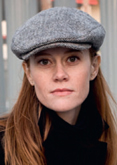
Figure 10.12
Kristin Ross Lauterbach, Director.
How do you select an actor for a production? Are there things that you specifically look for?
Go with your gut. Listen to that little voice that says, “This is right,” and definitely listen to it when it says “This is NOT right,” especially if it looks right on paper. It’s not. We read all type of subconscious body language without even realizing it.
I like to have a conversation with talent before I ever have them read a word of the script. I think performing the scene is more a formality, and it’s not the best representation of the actor; get to know them. I know what I am looking for, and when I see it, I know. In the past, when I didn’t listen to my gut, it always came back to bite me, and it made for very long, painful productions.
Kristin Ross Lauterbach has worked in television and film.
